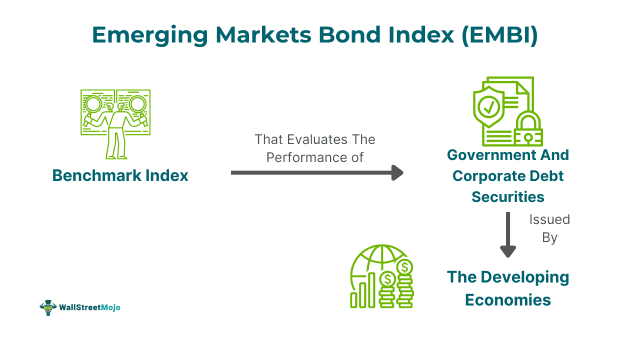Table of Contents
What Is The Emerging Markets Bond Index (EMBI)?
The emerging markets bond index (EMBI) is a global standard or benchmark that gauges the performance of government and corporate bonds issued by developing or growing nations that fulfill structural and liquidity criteria. These underlying debt instruments are listed on the secondary markets for trading.

Thus, the EMBI helps bond investors and traders measure the prevailing risk and return of their debt instrument holdings in growing economies against this benchmark index. Moreover, EMBI investors can ensure their funds are efficiently allocated across a globally diversified portfolio. Further, such bonds have higher earning potential than developed markets' debt securities.
Key Takeaways
- l An emerging markets bonds index (EMBI) is a benchmark that closely tracks the risk and returns of bonds issued by governments and corporations in developing nations.
- l The EMBI includes both fixed and flexible debt securities in local currencies or U.S. Dollar denominations.
- l These indexes have a high-risk profile, including the political, currency, and economic uncertainties prevailing in developing nations.
- Their returns are also higher than those of developed nations' debt instruments.
- l Investors can buy exchange-traded funds and mutual funds tracking the EMBI.
Emerging Markets Bond Index Explained
The emerging markets bond index (EMBI) is a standard index that chases the returns of the fixed and floating debt securities. These securities are issued by the sovereign and quasi-sovereign bodies and corporations of developing nations in foreign currency denominations like USD, Japanese Yen, or Euros. The EMBI is available on the secondary markets for exchange. Moreover, the index focuses on the debt instruments of nations with a heightened potential for growth due to the prevalence of free market economies and paced industrialization. Hence, the return potential of these bonds is usually much higher than that of the debt securities of developed countries.
Some of the promising E.M. economies include China, Brazil, Nigeria, Mexico, India, Russia, South Africa, Turkey, and Poland. These developing countries are the most preferred investment grounds for companies that aim for expansion since they have abundant natural resources, labor, and land available at a lower cost than developed nations.
Investors must recognize the risk of exposure to such investments. These bonds have a low credit rating due to their higher risk potential about these growing economies' political and economic uncertainties. There can be a high level of corruption and frequent changes in government regulations. Further, the financial markets of these nations are not well organized or developed and have a high transaction cost. Also, the currencies of these countries witness more volatility than the other developed economies. Therefore, investors who are ready to bear that extra risk for the immense capital appreciation and growth can consider the exchange-traded funds and mutual funds that track the EMBI.
Many traders use Saxo Bank International to research and invest in stocks across different markets. Its features like SAXO Stocks offer access to a wide range of global equities for investors.
EMBI Indices of J.P. Morgan
J.P. Morgan was known as the leader in introducing the emerging market's bond indexes in 1992. It issued the Brady bonds first and then developed the Government Bond Index-Emerging Markets (GBI-EM) and the Corporate Emerging Markets Bond Index (CEMBI). These indexes have become a global benchmark for investments in emerging markets debts. The company has introduced new region-specific indexes in the category, including the Russia Bond Index (RUBI), the J.P. Morgan Asia Credit Index (JACI), and the Latin America Eurobond Index (LEI). According to https://www.business-standard.com/markets/news/indian-govt-bonds-now-part-of-jp-morgan-s-bond-index-here-s-what-it-means-124062800086_1.html, India joined the GBI-EM with an initial 1% weight, which will gradually increase to 10% by March 31, 2025.
Let us now understand the process that J.P. Morgan Investment Bank uses to evaluate the EMBI in the following steps:
- Deciding EM Countries: The foremost consideration is selecting emerging market nations by gauging liquidity, market size, and accessibility for their eligibility for index inclusion.
- Picking Eligible Bonds: Next, the company finds the most suitable bonds of the selected nations, based on their size, maturity, and liquidity, to add to the index.
- Assigning Weights: According to the market value of the selected bonds, they are allocated a certain weightage.
- Calculating Bond Price and Yield: In this step, the company regularly collects and monitors the current bond price and yield data. While this price is critical for evaluating the bond's market value, the bond yields determine its efficiency in terms of performance.
- Computing EMBI: The value of the index is derived through the weighted average method.
- Managing the Index: J.P. Morgan monitors, reviews, and adjusts the index composition and inclusions to confirm that it is a relevant benchmark for global emerging market bonds.
Examples
An emerging markets bond index is an essential parameter for closely monitoring the performance of emerging markets and the potential of their debt securities. Given below are some examples to understand the significance of EMBI:
Example #1
Suppose ABC's emerging markets bond index is a benchmark index that tracks the performance of 87 different sovereign and corporate bonds of the emerging markets. 55% of the funds are allocated to the debt securities of the five largest growing economies, including Brazil, China, India, Mexico, and Russia. The PR ABC EMBI ETF closely follows this index. While the ABC EMBI surged by 13.7% in 2023, the PR ABC EMBI ETF investors earned an equivalent return on their investments. Moreover, the investors who have invested in the corporate bonds of Brazil saw only a 4.2% surge when compared to the ABC EMBI ETF.
Example #2
Venezuelan and Petróleos de Venezuela, S.A. (PDVSA) bonds have significantly surged after JPMorgan's announcement to re-weight these securities in its EMBI. The company plans to reconsider the worth of $53 billion of these previously defaulted bonds into EMB indexes over three months from April 30, 2024. Meanwhile, the Sovereign bonds rallied by up to 3 cents, while the 2027 notes embraced 21 cents per dollar. Also, the PDVSA's 2026 bonds upsurged by 2.5 cents to 11 cents.
In 2019, JPMorgan Chase & Co. curtailed the debt weights to 0 because of U.S. sanctions. However, the Biden administration has eased some of these restrictions last year. Therefore, the company decided to include 20 securities, consisting of $24 billion in PDVSA bonds and $29 billion in sovereign notes, in the JPMorgan Emerging Markets Bond Index Global and JPMorgan Emerging Markets Bond Index Global Diversified. Nevertheless, the JPMorgan Emerging Markets Bond Index Global Core Index will not include any of these securities.
Disclosure: This article contains affiliate links. If you sign up through these links, we may earn a small commission at no extra cost to you.

